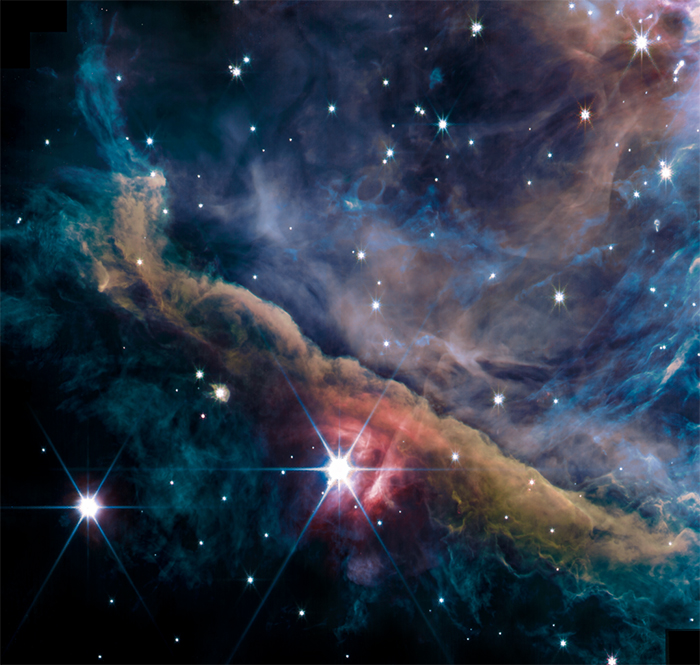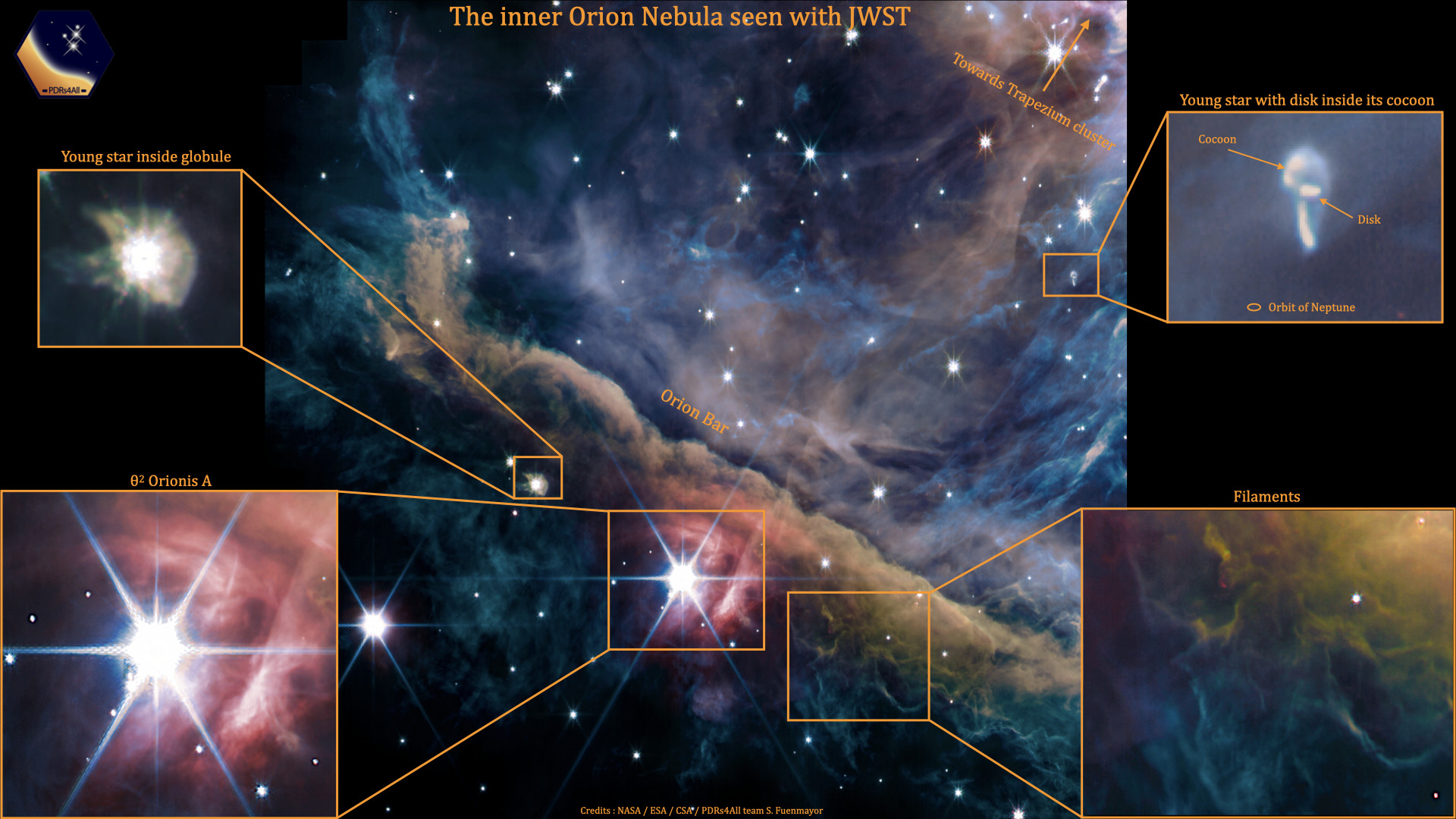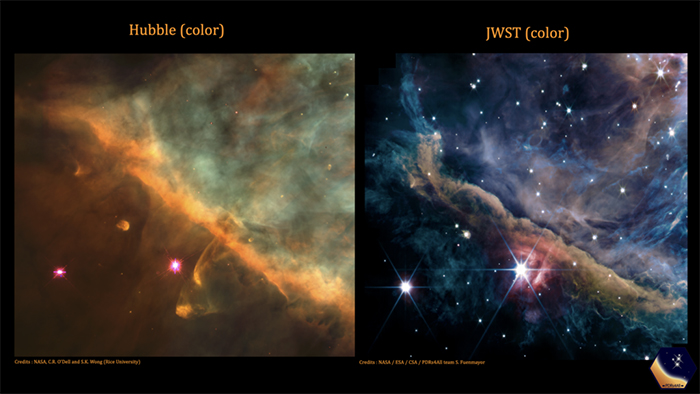James Webb Telescope: first images of the Orion Nebula
An international research team has just revealed the first images of the Orion Nebula, the richest and closest nursery of stars to the Solar System, captured by the James Webb Space Telescope. They demonstrate once again the exceptional performance of this instrument. Co-directed by scientists from CNRS, Université Paris-Saclay and University of Western Ontario (Canada), these observations also involved astronomers from Observatoire de Paris-PSL supported by CNES.
Dive into the birthplace of the stars… That’s what researchers have just achieved by capturing new images with the James Webb Space Telescope: the most detailed and sharpest images ever taken of the inner region of the Orion Nebula. These observations were made possible and confirmed by Webb’s revolutionary capabilities.
Located in the constellation of Orion, 1350 light-years from Earth, the Orion Nebula is an area rich in material where many stars are formed. It would be an environment similar to the one where our system was born more than 4.5 billion years ago: studying it allows us to better understand the conditions prevailing at that time.
The heart of star nurseries, like the Orion Nebula, is hidden by large amounts of dust. It is impossible to observe it in visible light with telescopes like Hubble. The James Webb Space Telescope observes the infrared light of the cosmos, and thus allows us to see through these layers of dust. It finally lifts the veil on what is going on in the depths of the nebula.
First of all, it reveals many spectacular structures, up to scales of about 40 AU (1) . Among them, a number of dense filaments of matter, which could favor the birth of a new generation of stars, as well as stellar systems in formation have been observed. The latter consist of a central protostar surrounded by a disk of dust and gas inside which planets are forming.
The Orion Nebula is also home to a cluster of massive young stars, called the Trapezium Cluster, which emits intense ultraviolet radiation, capable of shaping clouds of dust and gas. Understanding how this phenomenon impacts the environment is a key question for studying the formation of stellar systems like our own Solar System.
These results are the product of one of James Webb’s priority observing programs, which involved about 100 scientists in 18 countries (2) and was co-led by scientists from CNRS, Université Paris-Saclay and the University of Western Ontario (located in London, Canada). These programs were selected in an international call for proposals from the James Webb Space Telescope.
The research team is working to analyze the data collected about the Orion Nebula, and promises new discoveries about the early phases of the formation of stellar and planetary systems.

This is a composite image from several filters that represents emission from ionized gas, hydrocarbons, molecular gas, dust and scattered starlight. Most prominent is the Orion Bar, a wall of dense gas and dust that runs from the top left to the bottom right in this image, and that contains the bright star θ2 Orionis A. The scene is illuminated by a group of hot, young massive stars (known as the Trapezium Cluster) which is located just off the top right of the image. The strong and harsh ultraviolet radiation of the Trapezium cluster creates a hot, ionized environment in the upper right, and slowly erodes the Orion Bar away. Molecules and dust can survive longer in the shielded environment offered by the dense Bar, but the surge of stellar energy sculpts a region that displays an incredible richness of filaments, globules, young stars with disks and cavities.
Credit: NASA, ESA, CSA, Data reduction and analysis : PDRs4All ERS Team; graphical processing S. Fuenmayor
Technical details: The image was obtained with the James Webb Space Telescope NIRCam instrument on September 11, 2022. Several images in different filters were combined to create this composite image: F140M and F210M (blue); F277W, F300M, F323N, F335M, and F332W (green); F405N (orange); and F444W, F480M, and F470N (red).

Filaments: The entire image is rich in filaments of different sizes and shapes. The inset here shows thin, meandering filaments that are especially rich in hydrocarbon molecules and molecular hydrogen.
θ2 Orionis A: The brightest star in this image is θ2 Orionis A, a star that is just bright enough to be seen with the naked eye from a dark location on Earth. Stellar light that is reflecting off dust grains causes the red glow in its immediate surroundings.
Young star inside globule: When dense clouds of gas and dust become gravitationally unstable, they collapse into stellar embryos that gradually grow more massive until they can start nuclear fusion in their core – they start to shine. This young star is still embedded in its natal cloud.
Credit: NASA, ESA, CSA, Data reduction and analysis : PDRs4All ERS Team; graphical processing S. Fuenmayor & O. Berné

The inner region of the Orion Nebula as seen by both the Hubble Space Telescope (left) and the James Webb Space Telescope (right). The HST image is dominated by emission from hot ionized gas, highlighting the side of the Orion Bar which is facing the Trapezium Cluster (off the top right of the image). The JWST image also shows the cooler molecular material that is slightly further away from the Trapezium Cluster (compare the location of the Orion Bar relative to the bright star θ2 Orionis A for example). Webb’s sensitive infrared vision can furthermore peer through thick dust layers and see fainter stars. This will allow scientists to study what is happening deep inside the nebula.
Credit: NASA, ESA, CSA, PDRs4All ERS Team; image processing Olivier Berné.
Credit for the HST image: NASA/STScI/Rice Univ./C.O’Dell et al. – Program ID: PRC95-45a. Technical details: The HST image used WFPC2 mosaic.This composite image uses [OIII] (blue), ionized hydrogen (green), and [NII] (red).
Notes
- For Astronomical Unit. One AU is approximately the distance between the Earth and the Sun, 10 AU is the distance between Saturn and the Sun.
- In France, this research involved scientists from the Institut de recherche en astrophysique et planétologie (CNRS/CNES/UT3 Paul Sabatier), Institut d’astrophysique spatiale (CNRS/Université Paris-Saclay), Laboratoire d’études du rayonnement et de la matière en astrophysique et atmosphères (Observatoire de Paris – PSL/CNRS/Sorbonne Université/Université de Cergy-Pontoise), Institut des sciences moléculaires d’Orsay (CNRS/Université Paris-Saclay), Institut de planétologie et d’astrophysique de Grenoble (CNRS/UGA), Laboratoire de physique de l’École normale supérieure (CNRS/ENS-PSL/Sorbonne Université/Université Paris Cité), Laboratoire de physique des deux infinis Irène Joliot-Curie (CNRS/Université Paris Saclay), Institut de physique de Rennes(CNRS/Université de Rennes 1), Institut d’astrophysique de Paris (CNRS/Sorbonne Université), laboratoire Astrophysique, instrumentation, modélisation (CNRS/CEA/Université Paris Cité), Institut des sciences moléculaires (CNRS/Bordeaux INP/Université de Bordeaux), Laboratoire de chimie et physique quantiques (CNRS/UT3 Paul Sabatier).
Further Ressources
- Other Images : The inner Orion nebula seen with the JWST
- Press Review :
- Télescope James Webb : premières images de la nébuleuse d’Orion (CNES)
- Le télescope James-Webb saisit la pouponnière d’étoiles d’Orion (Le Monde)
- « Les images du James Webb Space Telescope sont extraordinaires » (CNRS Le Journal)
- JWST has caught hot stars destroying gas and dust in the Orion Nebula (New Scientist)
- Western researchers among first to capture James Webb Space Telescope images (Western News)
IRAP Contact
- Olivier Berné, olivier.berne@irap.omp.eu






